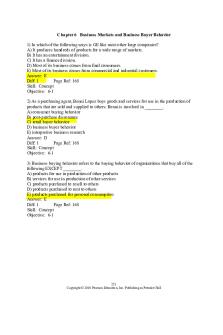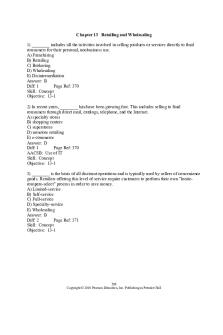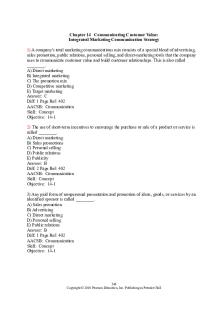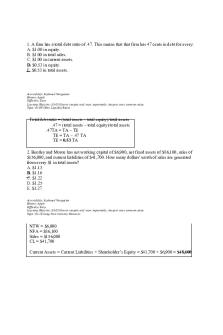Kotler Chapter 9 MCQ - Multiple choice questions with answers PDF

| Title | Kotler Chapter 9 MCQ - Multiple choice questions with answers |
|---|---|
| Course | Principles of Marketing |
| Institution | The University of the West Indies Mona |
| Pages | 40 |
| File Size | 231.1 KB |
| File Type | |
| Total Downloads | 332 |
| Total Views | 1,015 |
Summary
Chapter 9 New-Product Development and Product Life-Cycle Strategies What are the two ways that a company can obtain new products? A) line extension and brand management B) internal development and brand management C) new-product development and acquisition D) service development and product extensio...
Description
Chapter 9 New-Product Development and Product Life-Cycle Strategies 1) What are the two ways that a company can obtain new products? A) line extension and brand management B) internal development and brand management C) new-product development and acquisition D) service development and product extension E) market mix modification and research and development Answer: C Diff: 2 Page Ref: 258 Skill: Concept Objective: 9-1 2) Product improvements, product modifications, and original products can all be classified as ________. A) pioneer products B) new products C) product concepts D) product ideas E) test products Answer: B Diff: 1 Page Ref: 258 Skill: Concept Objective: 9-1 3) Which of the following is NOT a potential reason for a new product to fail? A) an underestimated market size B) a poorly designed product C) an incorrectly positioned product D) higher than anticipated costs of product development E) ineffective advertising Answer: A Diff: 2 Page Ref: 258 Skill: Concept Objective: 9-1
349 Copyright © 2010 Pearson Education, Inc. Publishing as Prentice Hall
4) Which of the following is NOT a challenge presented by the product life cycle that a firm must face? A) All products eventually decline. B) Changing tastes, technologies, and competition affect the marketing of the product as it passes through lifecycle stages. C) A firm must be good at developing new products to replace aging ones. D) A firm must be good at adapting its marketing strategies. E) It is difficult to plot the stages as a product goes through them. Answer: E Diff: 2 Page Ref: 258 Skill: Concept Objective: 9-1 5) The creation of a successful new product depends on a company's understanding of its ________ and its ability to deliver ________ to customers. A) competitors, distributors, and employees; new styles B) customers, brands, products; product images C) customers, competitors, and markets; superior value D) product, marketing mix, and marketing strategy; functional features E) product life cycle, legal responsibilities, and social responsibilities; innovations Answer: C Diff: 2 Page Ref: 259 Skill: Concept Objective: 9-2 6) New product development starts with ________. A) idea generation B) idea screening C) concept development D) concept testing E) test marketing Answer: A Diff: 1 Page Ref: 259 Skill: Concept Objective: 9-2 7) Executives, manufacturing employees, and salespeople are all examples of ________. A) external sources for new-product ideas B) internal sources for new-product ideas C) core members of innovation management systems D) research and development team members E) new-product committee members Answer: B Diff: 2 Page Ref: 260 AACSB: Communication Skill: Concept Objective: 9-2 350 Copyright © 2010 Pearson Education, Inc. Publishing as Prentice Hall
8) Your company decides to use internal sources for developing new product ideas. Which of the following would NOT be consulted? A) executives and professionals B) company records and data C) intrapreneurial programs D) suppliers E) salespeople Answer: D Diff: 1 Page Ref: 260 Skill: Concept Objective: 9-2 9) Which of the following is perhaps the most important external source of new-product ideas? A) engineers B) customers C) competitors D) trade magazines, shows, and seminars E) distributors and suppliers Answer: B Diff: 2 Page Ref: 261 AACSB: Communication Skill: Concept Objective: 9-2 10) Which of the following is NOT a recommended method for companies to tap into their customers as sources for new-product ideas? A) analyzing customer complaints and questions B) relying heavily on customers to know what types of technical products they need C) working alongside customers to get ideas and suggestions D) turning customers into cocreators E) putting customer-created products on the market Answer: B Diff: 3 Page Ref: 261 Skill: Concept Objective: 9-2 11) Your firm asks you to consult external sources for new product ideas. All of the following are common external sources EXCEPT ________. A) customers B) suppliers C) competitors D) trade shows and magazines E) the firm's executives Answer: E Diff: 1 Page Ref: 260-261 Skill: Concept Objective: 9-2 351 Copyright © 2010 Pearson Education, Inc. Publishing as Prentice Hall
12) The purpose of idea generation is to create a ________ number of ideas. The purpose of succeeding stages is to ________ that number. A) small number; reduce B) small number; increase C) large number; increase D) large number; reduce E) limited number; sustain Answer: D Diff: 2 Page Ref: 262 Skill: Concept Objective: 9-2 13) GrayBerry Gifts has just brainstormed a large number of ideas for adding new products and services after visiting several buying fairs. The owners will begin the first idea-reducing stage, called ________, to arrive at a realistic number to adopt. A) business analysis B) idea generation C) concept testing D) idea screening E) concept development Answer: D Diff: 2 Page Ref: 262 Skill: Concept Objective: 9-2 14) Which of the following is most likely to be included in an executive's write up of a newproduct idea to be presented to a new-product committee? A) the proposed customer value proposition B) the product image C) the marketing strategy D) the business analysis E) the planned marker rollout Answer: A Diff: 3 Page Ref: 262 Skill: Concept Objective: 9-2
352 Copyright © 2010 Pearson Education, Inc. Publishing as Prentice Hall
15) A detailed version of a new idea stated in meaningful customer terms is called a ________. A) product idea B) product concept C) product image D) product proposal E) product movement Answer: B Diff: 2 Page Ref: 262 AACSB: Communication Skill: Concept Objective: 9-2 16) A ________ is the way consumers perceive an actual or potential product. A) product idea B) product concept C) product image D) test market E) concept test Answer: C Diff: 1 Page Ref: 262 AACSB: Communication Skill: Concept Objective: 9-2 17) An attractive idea must be developed into a ________. A) product idea B) product concept C) product image D) test market E) product strategy Answer: B Diff: 2 Page Ref: 262 Skill: Concept Objective: 9-2 18) ________ calls for testing new-product concepts with groups of target consumers. A) Concept development B) Concept testing C) Idea generation D) Idea screening E) Test marketing Answer: B Diff: 1 Page Ref: 263 Skill: Concept Objective: 9-2
353 Copyright © 2010 Pearson Education, Inc. Publishing as Prentice Hall
19) In the concept testing stage of new-product development, a product concept in ________ form is presented to groups of target consumers. A) physical or symbolic B) prototype C) final D) market-tested E) commercial Answer: A Diff: 2 Page Ref: 263 Skill: Concept Objective: 9-2 20) With what groups do firms conduct concept testing for new products? A) suppliers B) employees C) target customers D) manufacturers E) competitors Answer: C Diff: 3 Page Ref: 263 Skill: Concept Objective: 9-2 21) For some ________, a simple description consisting of a word or picture might be sufficient. A) concept tests B) product concepts C) marketing strategies D) product developments E) business analyses Answer: A Diff: 2 Page Ref: 263 AACSB: Communication Skill: Concept Objective: 9-2 22) After concept testing, a firm would engage in which stage in developing and marketing a new product? A) idea screening B) marketing strategy development C) business analysis D) product development E) test marketing Answer: B Diff: 2 Page Ref: 263 Skill: Concept Objective: 9-2
354 Copyright © 2010 Pearson Education, Inc. Publishing as Prentice Hall
23) The first part of the marketing strategy statement describes the target market; the planned product positioning; and goals for sales, profits, and ________. A) market share B) competition C) secondary market D) competition's anticipated reaction E) life-cycle duration Answer: A Diff: 3 Page Ref: 263 Skill: Concept Objective: 9-2 24) The second part of the marketing strategy statement outlines the product's planned price, distribution, and ________ for the first year. A) advertising B) promotion C) marketing budget D) positioning E) target market Answer: C Diff: 3 Page Ref: 264 Skill: Concept Objective: 9-2 25) The third part of the marketing strategy statement includes all of the following EXCEPT ________. A) long-run sales B) profit goals C) marketing mix strategies D) short-run sales E) A and C Answer: D Diff: 3 Page Ref: 264 Skill: Concept Objective: 9-2 26) A review of the sales, costs, and profit projections for a new product to find out whether they satisfy the company's objectives is called a ________. A) business feasibility plan B) marketing strategy development C) business analysis D) product acceptance E) proposal Answer: C Diff: 1 Page Ref: 264 Skill: Concept Objective: 9-2 355 Copyright © 2010 Pearson Education, Inc. Publishing as Prentice Hall
27) During which stage of new-product development will management most likely estimate minimum and maximum sales to assess the range of risk in launching a new product? A) concept testing B) marketing strategy development C) business analysis D) product development E) test marketing Answer: C Diff: 2 Page Ref: 264 Skill: Concept Objective: 9-2 28) Once managers of The Grecian Urn have decided on their product concept and marketing strategy, they can evaluate the business attractiveness of the proposal in the ________ stage of the new-product development process. A) business feasibility B) feasibility study C) business analysis D) product acceptance E) concept testing Answer: C Diff: 2 Page Ref: 264 Skill: Concept Objective: 9-2 29) New World Releases is conducting a business analysis to determine which of the many new songs available to management should be released. Sales must be estimated before costs can be estimated. Which of the following did your text recommend for forecasting sales? A) conducting surveys of competitors B) considering the history of market opinions C) considering the sales history of similar products and conducting surveys of market opinions D) applying the PLC concept E) none of the above Answer: C Diff: 3 Page Ref: 264 Skill: Concept Objective: 9-2
356 Copyright © 2010 Pearson Education, Inc. Publishing as Prentice Hall
30) Once the product or service passes the business analysis test, it moves into what stage? A) concept development B) product development C) market testing D) strategy development E) product proposal Answer: B Diff: 2 Page Ref: 264 Skill: Concept Objective: 9-2 31) In the ________ stage of new-product development, products undergo rigorous tests to make sure that they perform safely and effectively or that consumers will find value in them. A) business analysis B) idea generation C) concept development and testing D) product development E) marketing mix Answer: D Diff: 2 Page Ref: 264 Skill: Concept Objective: 9-2 32) Once the prototype of Wainwright Industries' new riding lawnmower, made especially for women, passes product tests, the next step is ________. A) test marketing B) focus group surveys C) commercialization D) post-testing E) business analysis Answer: A Diff: 2 Page Ref: 265 Skill: Concept Objective: 9-2 33) Bonneville Communications is concerned about test marketing its new device. Which of the following is NOT a disadvantage of test marketing that would likely concern Bonneville Communications? A) Test marketing costs can be high. B) It can take a lot of time to test market. C) Test marketing allows time for competitors to spy and gain advantages. D) People who are surveyed tend to tell less than the truth. E) Test marketing does not guarantee success. Answer: D Diff: 3 Page Ref: 265 Skill: Concept Objective: 9-2 357 Copyright © 2010 Pearson Education, Inc. Publishing as Prentice Hall
34) Under what circumstances might it be wise for a company to do little or no test marketing? A) when a new product requires a major investment B) when management is not sure of the product C) when management is not sure of the marketing program D) when the product has no substitutes and is new in its category E) when the costs of developing and introducing the product are low Answer: E Diff: 2 Page Ref: 265 Skill: Concept Objective: 9-2 35) Although test marketing costs can be high, they are often small when compared with ________. A) the final results B) the costs of a major mistake C) management's approval and acceptance D) stockholders' confidence E) research and development costs Answer: B Diff: 2 Page Ref: 265 Skill: Concept Objective: 9-2 36) Many marketers are now using new interactive technologies, such as Frito-Lay's online virtual convenience store, to reduce the cost of ________. A) concept development B) concept testing C) marketing strategy development D) product development E) test marketing Answer: E Diff: 2 Page Ref: 267 Skill: Concept Objective: 9-2 37) The major purpose of test marketing is to provide management with the information needed to make a final decision about ________. A) how to develop a market strategy B) which market to compete in C) whether to launch the new product D) how to compete in the market E) how long to compete in the market Answer: C Diff: 3 Page Ref: 268 Skill: Concept Objective: 9-2
358 Copyright © 2010 Pearson Education, Inc. Publishing as Prentice Hall
38) Introducing a new product into the market is called ________. A) test marketing B) new product development C) experimenting D) commercialization E) marketing development Answer: D Diff: 2 Page Ref: 268 Skill: Concept Objective: 9-2 39) Which of the following costs is most likely associated with the commercialization stage of new-product development? A) building or renting a manufacturing facility B) paying groups of target customers for product feedback C) determining the product's planned price, distribution, and marketing budget D) developing a prototype of the product E) identifying target markets Answer: A Diff: 2 Page Ref: 268 Skill: Concept Objective: 9-2 40) A company getting ready to launch a new product must make several decisions. The company must first decide on ________. A) whether to launch the product in a single location B) whether to launch the product in a region C) whether to launch the product into full national distribution D) when to time the new product introduction E) when to develop a planned market rollout Answer: D Diff: 2 Page Ref: 268 Skill: Concept Objective: 9-2 41) Following the decision to "time" the introduction of the new product, a company must decide ________ to launch the new product. A) where B) how C) to what degree D) why E) all of the above Answer: A Diff: 2 Page Ref: 268 Skill: Concept Objective: 9-2
359 Copyright © 2010 Pearson Education, Inc. Publishing as Prentice Hall
42) Which of the following is necessary for successful new-product development? A) a holistic and sequential product development approach B) a customer-centered, team-based, systematic approach C) a team-based, innovation-management approach D) a market pioneer mindset and a holistic approach E) an innovation management system and sequential product development Answer: B Diff: 3 Page Ref: 268 Skill: Concept Objective: 9-2 43) Which stage of the new-product development process focuses on finding new ways to solve customer problems and create more customer-satisfying experiences? A) concept testing B) new-product development C) customer-centered new-product development D) sequential product development E) team-based new-product development Answer: C Diff: 1 Page Ref: 269 Skill: Concept Objective: 9-2 44) ________ is a new-product development approach in which one company department works to complete its stage of the process before passing the new product along to the next department and stage. A) Team-based product development B) Simultaneous product development C) Sequential product development D) Product life-cycle analysis E) Micromarketing Answer: C Diff: 2 Page Ref: 269 Skill: Concept Objective: 9-2 45) In order to get their new products to market more quickly, many companies are adopting a faster, team-oriented approach called ________. A) simulated new-product development B) sequential product development C) team-based new-product development D) phased-in new-product development E) market development Answer: C Diff: 1 Page Ref: 270 Skill: Concept Objective: 9-2 360 Copyright © 2010 Pearson Education, Inc. Publishing as Prentice Hall
46) The team-based new-product development approach is faster because departments work closely together through ________. A) team efforts B) a step-by-step process C) the help of a consultant D) cross-functional teams E) departmentalization Answer: D Diff: 2 Page Ref: 270 AACSB: Communication Skill: Concept Objective: 9-2 47) The team-based new-product development approach uses cross-functional teams that overlap the steps in the process to achieve which of the following goals? A) save time and reduce errors B) save time and increase effectiveness C) increase effectiveness and employee satisfaction D) speed product to market and reduce costs E) B and D Answer: B Diff: 2 Page Ref: 270 Skill: Concept Objective: 9-2 48) Which of the following is a disadvantage of a team-based approach to new-product development? A) It takes longer to get the right products to market. B) The development effort is not as effective because of team members' lack of expertise. C) Levels of risk can be more easily controlled. D) Organizational confusion and tension can affect the process. E) The process does not work with the shorter life cycles of many of today's products. Answer: D Diff: 2 Page Ref: 270 AACSB: Communication Skill: Concept Objective: 9-2
361 Copyright © 2010 Pearson Education, Inc. Publishing as Prentice Hall
49) The innovation management system approach yields two favorable outcomes: it helps create an innovation-oriented company culture, and it ________. A) clearly assigns responsibility for the process B) yields a larger number of new-product ideas C) guarantees successful products D) frees up senior management time E) requires less budget support Answer: B Diff: 3 Page Ref: 272 Skill: Concept Objective: 9-2 50) The search for new-product ideas should be ________ rather than haphazard. A) intermittent B) systematic C) segmented D) strategically planned E) rare Answer: B Diff: 2 Page Ref: 271 Skill: Concept Objective: 9-2 51) ________ is the product life cycle period when sales fall off and profits drop. A) Introduction B) Growth C) Maturity D) Decline E) Development Answer: D Diff: 1 Page Ref: 273 Skill: Concept Objective: 9-3 52) Increasing profits will most likely occur at which stage of the PLC? A) introduction B) maturity C) growth D) decline E) product development Answer: C Diff: 1 Page Ref: 273 Skill: Concept Objective: 9-3
362 Copyright © 2010 Pearson Education, Inc. Publishing as Prentice Hall
53) Which stage in the PLC is characterized by rapid market acceptance and increasing sales? A) introduction B) maturity C) growth D) decline E) development Answer: C Diff: 1 Page Ref: 273 Skill: Concept Objective: 9-3 54) Some products that have entered the decline stage have been cycled back to the growth stage through ________. A) promotion or repositioning B) concept testing C) business analysis D) innovation management E) customer-centered product development Answer: A Diff: 2 Page Ref: 273 Skill: Concept Objective: 9-3 55) All of the following are stages in the PLC EXCEPT ________. A) introduction B) growth C) maturity D) adoption E) decline Answer: D Diff: 1 Page Ref: 273 Skill: Concept Objective: 9-3 56) Which stage of the typical consumer product life cycle is out of order below? A) product development B) introduction C) maturity D) growth E) decline Answer: C Diff: 2 Page Ref: 273 Skill: Concept Objective: 9-3
363 Copyright © 2010 Pearson Education, Inc. Publishing as Prentice Hall
57) Which of the following CANNOT be described using the PLC concept? A) product class B) product form C) product image D) brand E) styles Answer: C Diff: 3 Page Ref: 273 Skill: Concept Objective: 9-3 58) All of the following are accurate descriptions of a style product, EXCEPT which one? A) Style products appear in h...
Similar Free PDFs
Popular Institutions
- Tinajero National High School - Annex
- Politeknik Caltex Riau
- Yokohama City University
- SGT University
- University of Al-Qadisiyah
- Divine Word College of Vigan
- Techniek College Rotterdam
- Universidade de Santiago
- Universiti Teknologi MARA Cawangan Johor Kampus Pasir Gudang
- Poltekkes Kemenkes Yogyakarta
- Baguio City National High School
- Colegio san marcos
- preparatoria uno
- Centro de Bachillerato Tecnológico Industrial y de Servicios No. 107
- Dalian Maritime University
- Quang Trung Secondary School
- Colegio Tecnológico en Informática
- Corporación Regional de Educación Superior
- Grupo CEDVA
- Dar Al Uloom University
- Centro de Estudios Preuniversitarios de la Universidad Nacional de Ingeniería
- 上智大学
- Aakash International School, Nuna Majara
- San Felipe Neri Catholic School
- Kang Chiao International School - New Taipei City
- Misamis Occidental National High School
- Institución Educativa Escuela Normal Juan Ladrilleros
- Kolehiyo ng Pantukan
- Batanes State College
- Instituto Continental
- Sekolah Menengah Kejuruan Kesehatan Kaltara (Tarakan)
- Colegio de La Inmaculada Concepcion - Cebu















